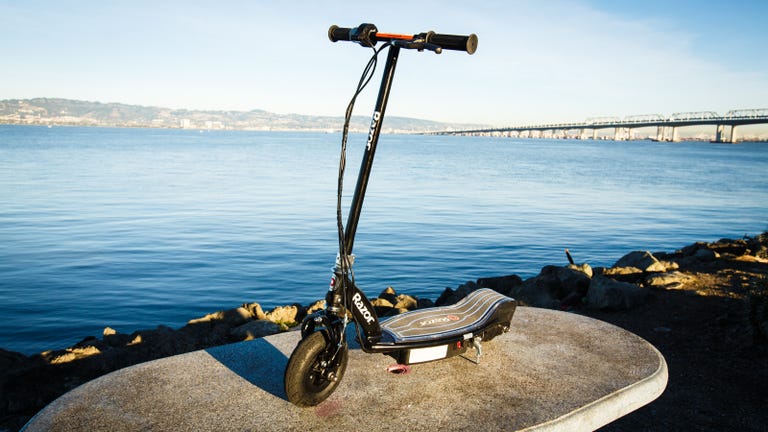 Why You Can Trust CNET
Why You Can Trust CNET Razor E100 Glow electric scooter review: Razor's kid-size electric scooter rides easy and loud
The Razor E100 Glow, built for children, makes for easy electric riding on smooth surfaces, but offers only basic features.
When I was growing up, older kids got to speed around on mini-bikes powered by lawnmower engines, while I pedaled furiously on my Big Wheel. Thanks to cheap electronics, children now have access to a wealth of motor-driven vehicles, such as the Razor E100 Glow electric scooter.
The Good
The Bad
The Bottom Line
Yes, Razor: the same company that made all those lightweight push scooters everyone seemed to be riding at the turn of this century. The company has since expanded its lineup, offering a range of electric scooters.
After unboxing the E100 Glow, Razor's smallest scooter, I had it assembled in minutes using the included hex wrench. I snagged its charger from the box, found the port on the side of the E100, and plugged it in. While it sat there, I admired its black, tubular construction. I couldn't wait to grab the handlebars and put my feet on the deck, covered with non-skid rubber. As a bit of decoration, Razor includes a strip of blue LED lights around the edge of the deck, hence the "glow" in its model name.
Those LEDs are about it for extras. The E100 lacked much of anything beyond its brake, accelerator and kickstand. I looked in vain for a charge indicator or any kind of front or rear lights, which would make this scooter a little safer to ride in the evening.
The front brake was a simple caliper, similar to that on bicycles. Under the deck, the specifications noted that there were two lead-acid batteries. The E100's motor turns the rear wheel with a chain drive. Lead-acid batteries, the same type used for decades to power starter motors in cars, seemed a little primitive to me in this era, when lithium-ion appears in most electronics.
Perusing the manual, drinking in specs such as its maximum 10 mph speed and 40 minute ride time on a full charge, I was dismayed to read that the maximum rider weight was 120 pounds (54 kg). I left that weight behind many decades ago.
Fortunately, CNET editors come in many sizes, so I pulled the rather more petite Lynn La from her usual smartphone beat to ride the E100 Glow and let me know what it felt like.
"The E100 has a solid build quality and feels like a stable and sturdy ride," Lynn reported back. "It did well to support me, and at no point did I feel that it was going to buckle under my weight. Its deck is also wide enough so that my feet could adjust freely while riding. The glowing LED lights, while not exactly up to safety regulation standards for riding at night, are a nice goodie to have as well.
"But as stable as it felt, it's definitely not a smooth ride. Though riding on carpet or smooth sidewalk didn't seem like much of a problem, on slightly rougher concrete I could feel every crack and groove rumbling beneath my feet due to the hard rear wheel. I also found it difficult to keep the accelerator twisted back without my hand getting sore. Because of that, I wouldn't recommend the E100 for long rides, anything exceeding about 30 minutes. Lastly, the motor is quite loud. This may not bother a lot of people, but for long periods it became a little grating and irritating."
After Lynn's test ride, I actually did get on the E100. It did not immediately crumble under my weight, but its electric drive system probably wouldn't have performed at its full potential. I confirmed Lynn's impressions that it was a noisy ride and not all that comfortable. In particular, the solid rear wheel, made from urethane, conveyed too much vibration from rough pavement to my legs.
Children, the target rider for the Razor E100 Glow, will likely overlook many of this scooter's drawbacks when presented with its easy-riding fun. The lack of lighting could be remedied with bicycle lights, or parents may just want to make sunset the curfew for riding. As it doesn't include any sort of lock, and the structure of the scooter doesn't present any good holes or anchors for a bicycle lock, the E100 is best kept close to home.
At a price of about $130, £120 or AU$259, the E100 may not be too expensive for a holiday gift, although a bicycle will likely last longer. The E100's main drawback are its batteries, which will require regular use and charging to maintain their power. Charge cycles for lead-acid batteries will likely limit the E100 to about five years, but a child will outgrow it in that amount of time.




